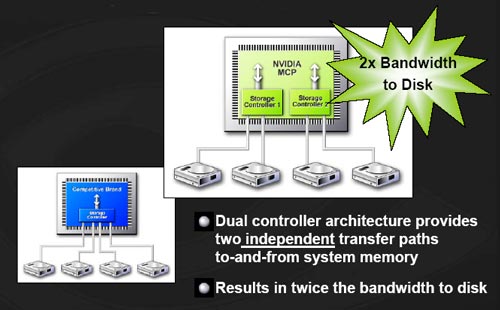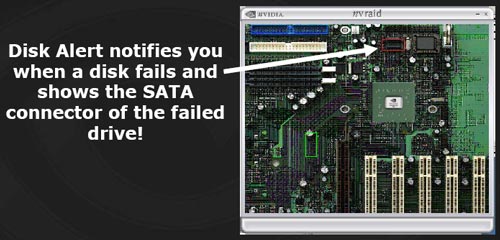nForce4: PCI Express and SLI for Athlon 64
by Wesley Fink on October 19, 2004 12:01 AM EST- Posted in
- CPUs
3Gb/s SATA
nVidia pioneered "any drive" integrated RAID capabilities with the nForce3-250 chipset. This included support for 4 SATA drives and 4 PATA drives that could be combined in RAID 0, 1, and 0+1 configurations. For nForce4, nVidia has taken SATA support even further by providing two independent SATA controllers on the nForce 4 Ultra and nForce4 SLI chipsets.
The Dual SATA controllers on the nF4 also support the upcoming 3Gb/sec SATA drives, which are now sampling. The new 3Gb/s SATA drives should start appearing in the market around the end of the year, which will provide nForce4 users with an upgrade path to improved hard drive performance. The nForce4 also supports drives with NCQ (Native Command Queuing).
Cross-Controller RAID
The unique cross-controller RAID is continued in the nForce4 chipset. This means that both Serial ATA (SATA) and parallel ATA disk devices can be combined within a single RAID array. Users don't need to worry about whether hard drives are SATA or IDE - the nVidia RAID controller treats both IDE and SATA drives the same and allows them to be combined in any way in the RAID controller. A single setup procedure applies to all drives, which makes it possible to use all the storage devices available. Users can also expand the number of drives easily without worrying about whether the drive is IDE or SATA.Spare Disk Allocation
Corporate RAID users are accustomed to RAID arrays with "hot spares" and on-the-fly rebuilds, but those RAID 5 features have been an expensive addition to a home PC. If a disk fails, RAID 1 allows continuous operation by taking advantage of the mirrored data copy in the array. The nVidia RAID solution goes a step further and lets a user rebuild a new mirrored copy for the data while the system is up and running, without disrupting user and application access to the data set. Rebuilding on the fly eliminates down time and maximizes protection for critical storage resources.The nVidia RAID controller allows the user to add hot spare features to a home PC that is running any type of mirroring on the nVidia RAID controllers. Users can designate spare drives that can be configured as hot standbys, protecting arrays in the event of a disk failure. A shared spare can protect multiple arrays of drives, or a dedicated spare can serve as a hot standby for a particular drive array. The spare disk feature, which offers protection that goes beyond mirroring data, has been traditionally limited to high-end RAID systems, but this feature is built into the nForce4 RAID controllers. This isn't RAID 5 on a home PC, but the flexibility and data protection capabilities are truly impressive.
Disk Alert
One of the clever options available with the nForce4 is a feature called Disk Alert. With the large number of drives supported on the nForce4, it is not always an easy task to determine which drive has failed in the event of a pulled cable or other drive problem.
Disk Alert pops up a picture of the motherboard and shows exactly which drive connection has failed. This is a really slick idea, but we are still dependent on motherboard manufacturers to supply an accurate picture or diagram to embed in the alert feature.
Morphing From One RAID Array to Another
Morphing is the ability to convert from one RAID mode to another RAID mode. This allows the user to upgrade their current disk or array for better performance, higher security, and increased capacity. More importantly, this is accomplished without having to go through multiple steps. The morphing feature gives the user an upgradeable option to manage storage easily.In a traditional RAID environment, when a user wants to change the current state of a disk or a current array to a new RAID configuration, reconfiguring the new array involves a number of steps. The user must back up the data, delete the array, re-boot the PC, and then reconfigure the new array. NVIDIA RAID allows the end user to change the current state of the disk or array to another with a one-step process called "Morphing".
In general, to morph a RAID, the new array capacity must be equal to or greater than the previous array. For example, it is possible to morph from a RAID 1 array to a RAID 0 array as long as the RAID 0 array is the same size as (or larger than) the RAID 1 array. There are some limitations to RAID morphing, however. You can't morph to or from a JBOD (Spanning) array, from RAID 1 to RAID 1, or from RAID 0+1 to RAID 1.










101 Comments
View All Comments
SMT - Tuesday, October 19, 2004 - link
GG putting DOOM3 on the DX9 page.R3MF - Tuesday, October 19, 2004 - link
lol, i have an NF7-S too.somehow, despite all the good things about the NF3 250GB chipset i just wasn't compelled to go and buy an A64 rig, it may have had something to do with an adverse fear of Creative Scabs cards.
Araemo - Tuesday, October 19, 2004 - link
#35, you may be right about their driver writers..but they still write better drivers than any other consumer-level audio I've used in quite some time. (Ensoniq had decent drivers in the day, but guess who bought them?)
Now isn't THAT a scary thought?
Granted, I'm currently using soundstorm on my NF7-S, but I dislike the limited hardware 3d channels. I've had usefull sounds in games(like the gun that is shooting at me) be silent, while I hear other sounds like my footsteps, and the other 30 guns around me..
Araemo - Tuesday, October 19, 2004 - link
"So any chipset that supports pci-e should handle sli just fine, as long as the mobo maker puts two physical 16x slot connectors, regardless of their actual bandwidth."Negative.
a 1x lane w/ a 16x connector would not be enough bandwidth for the second card.
Yes, 4x is enough for most current games, just like noone currently needs AGP8x.
However, having one video card on a 16x lane and one on a 4x lane is a very screwy setup. What if that second video card temporarily needs the lions share of the bandwidth? Using two 8x lanes w/ 16x connectors seems like a much better way to me, if only because it balances the load between the cards better.
Speedo - Tuesday, October 19, 2004 - link
Here's another one, dissapointed about no updated audio sollution. Going from an nForce2 sollution, slapping in an old SB Live card or something doesn't sound that exciting...knitecrow - Tuesday, October 19, 2004 - link
I am not sure how NVIDIA came to the conclusion that audio was not a factor in buying decision. But it is the stupidest thing i have heard.If my memory serves, didn't NVIDIA originally say somewhere that they didn't see a need for audio based on the hardware reviews?
Anyway, the conclusion is all wrong. For those of us building media PC to hook up to an audio receiver, the original soundstorm on nforce2 was a great option.
For gamers who did not want to pay $100 for creative cards, sound storm provided a better solution than your typical mobo audio that didn’t have any DSP.
Many hardware enthusiasts love soundstorm. Anandtech is a hardware enthusiast site. I think it has a role to play in advocating consumer needs. Everyone made such a fuss over AGP/PCI bus locks (a feature that only interests overclockers, a minority) that NVIDIA and VIA had to put locks in.
I have to agree with #34
It does seem a bit draconian to make no mention of it at all. The criticism should be leveled against manufactures when required.
To say the issue has been dealt with or that it is old news, is simply being lazy.
The lack of soundstorm is a big problem. Its real, its relevant and it effects readers of Anandtech.
R3MF - Tuesday, October 19, 2004 - link
and nor has any other preview made mention! what parts of the NDA have not expired, and when will they expire are questions i'd like the answer too.either nVidia has an ace up its sleeve, or it has nothing and structured the NDA in such a way that the initial wave of publicity across the web focused on the NF4's good points, and did not dwell on the lack of SS2.
i could forgive nVidia the lack of SS2, but not limiting audio to AC97. i loath Creative Labs gear with a passion, if only cos there drivers appear to be written by a bunch of howling monkeys jumping up and down in a skip full of broken keyboards, i do not want to be forced to buy one!
R3MF - Tuesday, October 19, 2004 - link
but why did your preview make [b]NO[/b] mention of audio at all? to the point whereby it seems you are being arm-twisted to avoid the subject entirely?Wesley Fink - Tuesday, October 19, 2004 - link
Audio Comments -nVidia has not had SoundStorm on any nForce3 chipset. This means that for the past year+ SoundStorm has been "missing" on any nVidia chipset for Athlon 64.
We raised this issue for nForce3-150, then for nForce3-250 at http://www.anandtech.com/cpuchipsets/showdoc.aspx?... By now the change in nVidia audio on A64 is only news to those who are still using an nF2 motherboard.
nVidia has hinted that an updated audio solution is possibly in the works, which may come to market as a standalone card. But don't hold your breath. The data we have seen showed SoundStorm had little impact on the buying decision, which is one of the reasons nVidia dropped it for Athlon 64.
R3MF - Tuesday, October 19, 2004 - link
i swear the anand data-sheet on the CK8 chipset indicated that the sound would be some variety of high-definition audio, but on checking the link now (via nforcershq) the audio is only listed as just that, audio?